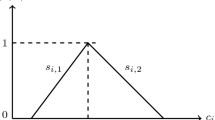Abstract
It is difficult to determine precise values for the parameters in the real world problems. To model the uncertainty, a new fuzzy linear programming model, called β-tolerance linear programming model, is developed in this paper. When the fuzzy numbers are all triangle fuzzy numbers, the solutions, which propose a selection interval for the decision maker, are obtained.
Access this chapter
Tax calculation will be finalised at checkout
Purchases are for personal use only
Preview
Unable to display preview. Download preview PDF.
Similar content being viewed by others
References
Buckley, J.J.: Fuzzy programming and Pareto optimal set. Fuzzy Sets and Systems 10, 57–63 (1983)
Cai, X., Teo, K.L., Yang, X., Zhou, X.Y.: Portfolio optimization under a Minimax rule. Management Science 16, 957–972 (2000)
Chen, L.H., Lu, H.W.: An approximate approach for ranking fuzzy numbers based on left and right dominance. Computers Math. Applic. 41, 1589–1602 (2001)
Chen, L.H., Lu, H.W.: The preference order of fuzzy numbers. Computers and Mathematics with Applications 44, 1455–1465 (2002)
Chu, T.C., Tsao, C.T.: Ranking fuzzy numbers with an area between the centroid point and original point. Computers and Mathematics with Applications 43, 111–117 (2002)
Dehghan, M., Hashemi, B.: Solution for the fully fuzzy linear systems using the decomposition procedure. Applied Mathematics and Computation 182, 1568–1580 (2006)
Dehghan, M., Hashemi, B., Ghatee, R.: Computational methods for solving fully fuzzy linear systems. Applied Mathematics and Computation 179, 328–343 (2006)
Dehghan, M., Hashemi, B., Ghatee, R.: Solution of the fully fuzzy linear systems using iterative techniques. Chaos Solutions and Fractals 34, 316–336 (2007)
Dubois, D., Prade, H.: Fuzzy Sets and Systems: theory and applications. Academic Press, London (1980)
Fang, S.C., Hu, C.F., Wang, H.F., Wu, S.Y.: Linear programming with fuzzy coefficients in constraints. Computers and mathematics with Applications 37, 63–76 (1993)
Liu, H.K., Wu, B., Liu, M.L.: Investors preference order of fuzzy numbers. Computers and Mathematics with Applications 55, 2623–2630 (2008)
Hosseinzadeh Lotfi, F., Allahviranloo, T., Alimardani Jondabeh, M., Alizadeh, L.: Solving a full fuzzy linear programming using lexicography method and fuzzy approximate solution. Applied Mathematical Modeling 33, 3151–3156 (2009)
Markowitz, H.: Portfolio selection. Journal of Finance 7, 77–97 (1952)
Ramik, J., Rimanek, J.: Inequality relation between fuzzy numbers and its use in fuzzy optimization. Fuzzy Sets and Systems 16, 21–29 (1989)
Ramik, J., Rommelfanger, H.: A single- and multi-valued order on fuzzy numbers and its use in linear programming with fuzzy coefficients. Fuzzy Sets and Systems 57, 203–208 (1993)
Xu, Z., Chen, J.: An interactive method for fuzzy multiple attribute group decision making. Information Sciences 177, 248–263 (2007)
Yao, J.S., Wu, K.: Ranking fuzzy numbers based on decomposition principle and signed distance. Fuzzy Sets and Systems 116, 275–288 (2000)
Yong, D., Zhu, Z., Liu, Q.: Ranking fuzzy numbers with an area method using radius of gyration. Computers and Mathematics with Applications 51, 1127–1136 (2006)
Zimmermann, H.J.: Fuzzy Set Theory and Its Applications. Kluwer Academic, Norwell (1991)
Author information
Authors and Affiliations
Editor information
Editors and Affiliations
Rights and permissions
Copyright information
© 2011 Springer-Verlag Berlin Heidelberg
About this paper
Cite this paper
Liu, HK., Wu, B. (2011). A New Fuzzy Linear Programming Model and Its Applications. In: Li, S., Wang, X., Okazaki, Y., Kawabe, J., Murofushi, T., Guan, L. (eds) Nonlinear Mathematics for Uncertainty and its Applications. Advances in Intelligent and Soft Computing, vol 100. Springer, Berlin, Heidelberg. https://doi.org/10.1007/978-3-642-22833-9_78
Download citation
DOI: https://doi.org/10.1007/978-3-642-22833-9_78
Publisher Name: Springer, Berlin, Heidelberg
Print ISBN: 978-3-642-22832-2
Online ISBN: 978-3-642-22833-9
eBook Packages: EngineeringEngineering (R0)




